Unit 7 Will people have robots 全单元教案设计
- 格式:doc
- 大小:85.00 KB
- 文档页数:14
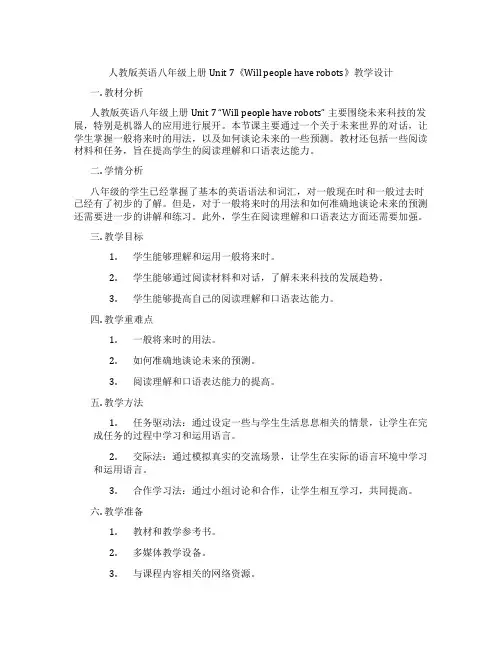
人教版英语八年级上册Unit 7《Will people have robots》教学设计一. 教材分析人教版英语八年级上册Unit 7 “Will people have robots” 主要围绕未来科技的发展,特别是机器人的应用进行展开。
本节课主要通过一个关于未来世界的对话,让学生掌握一般将来时的用法,以及如何谈论未来的一些预测。
教材还包括一些阅读材料和任务,旨在提高学生的阅读理解和口语表达能力。
二. 学情分析八年级的学生已经掌握了基本的英语语法和词汇,对一般现在时和一般过去时已经有了初步的了解。
但是,对于一般将来时的用法和如何准确地谈论未来的预测还需要进一步的讲解和练习。
此外,学生在阅读理解和口语表达方面还需要加强。
三. 教学目标1.学生能够理解和运用一般将来时。
2.学生能够通过阅读材料和对话,了解未来科技的发展趋势。
3.学生能够提高自己的阅读理解和口语表达能力。
四. 教学重难点1.一般将来时的用法。
2.如何准确地谈论未来的预测。
3.阅读理解和口语表达能力的提高。
五. 教学方法1.任务驱动法:通过设定一些与学生生活息息相关的情景,让学生在完成任务的过程中学习和运用语言。
2.交际法:通过模拟真实的交流场景,让学生在实际的语言环境中学习和运用语言。
3.合作学习法:通过小组讨论和合作,让学生相互学习,共同提高。
六. 教学准备1.教材和教学参考书。
2.多媒体教学设备。
3.与课程内容相关的网络资源。
七. 教学过程1.导入(5分钟)通过向学生展示一些机器人的图片,引起学生的兴趣,然后提问:“你们认为未来的人们会拥有机器人吗?”,让学生发表自己的看法。
2.呈现(10分钟)老师通过讲解和示范,向学生介绍一般将来时的用法,并举例说明如何准确地谈论未来的预测。
3.操练(10分钟)学生分组进行角色扮演,模拟真实的交流场景,运用一般将来时进行对话。
老师对学生的表现进行指导和评价。
4.巩固(10分钟)学生阅读教材中的阅读材料,理解并回答相关问题。
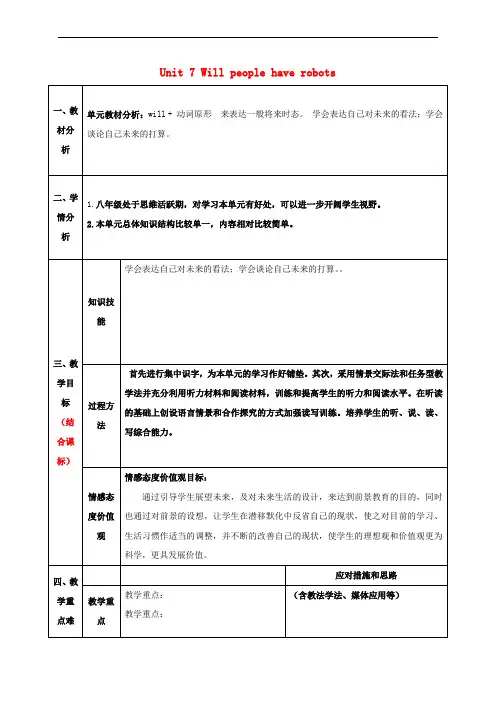
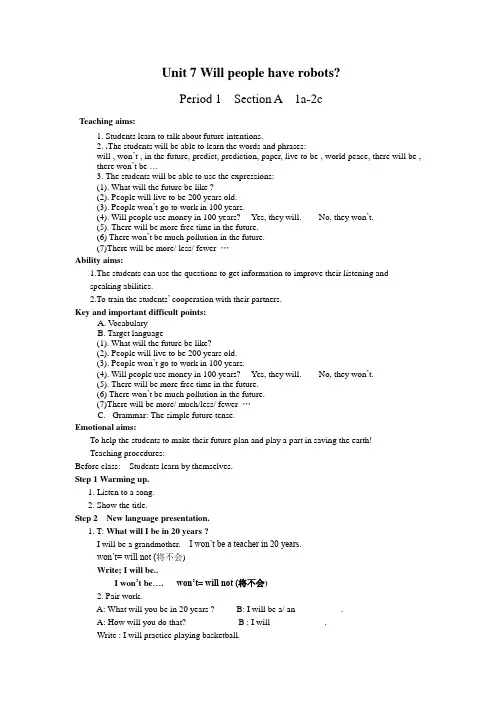
Unit 7 Will people have robots?Period 1 Section A 1a-2cTeaching aims:1. Students learn to talk about future intentions.2. .The students will be able to learn the words and phrases:will , won’t , in the future, predict, prediction, paper, live to be , world peace, there will be , there won’t be …3. The students will be able to use the expressions:(1). What will the future be like ?(2). People will live to be 200 years old.(3). People won’t go to work in 100 years.(4). Will people use money in 100 years?--- Yes, they will. ---No, they won’t.(5). There will be more free time in the future.(6) There won’t be much pollution in the future.(7)There will be more/ less/ fewer …Ability aims:1.The students can use the questions to get information to improve their listening andspeaking abilities.2.To train the students’ cooperation with their partners.Key and important difficult points:A. VocabularyB. Target language(1). What will the future be like?(2). People will live to be 200 years old.(3). People won’t go to work in 100 years.(4). Will people use money in 100 years?--- Yes, they will. ---No, they won’t.(5). There will be more free time in the future.(6) There won’t be much pollution in the future.(7)There will be more/ much/less/ fewer …C.Grammar: The simple future tense.Emotional aims:To help the students to make their future plan and play a part in saving the earth!Teaching procedures:Before class: Students learn by themselves.Step 1 Warming up.1. Listen to a song.2. Show the title.Step 2 New language presentation.1. T: What will I be in 20 years ?I will be a grandmother. I won’t be a teacher in 20 years.won’t= will not (将不会)Write; I will be..I won’t be…. won’t= will not (将不会)2. Pair work.A: What will you be in 20 years ? B: I will be a/ an __________.A: How will you do that? B : I will ____________.Write : I will practice playing basketball.3. T; What will our life be like in 100 years?(1). Demonstrate; Learn and read.(2). Students learn in their group.(3). Read.Step 3 Work on 1a.1. Read the sentences.2. How will the world be different 100 years from now? Read the predictions in 1a. Check Afor agree or D for disagree.3. Show their answers: I agree /disagree that ____________________.Step 4 Work on 1b.1. T: Now listen to the recording and circle the predictions you hear in 1a.2. Play the recording for the Ss to listen and circle the predictions.3. Play the recording again.4. Check the answers with the Ss.5. Read .Step 5.Pair work.1. Let Ss read the first conversation in 1c after the teacher.2. Then let Ss ask and answer questions about the predictions in 1a. Then make their ownconversation.3. Let some pairs ask and answer about their conversations.Step 6Step 2 New language presentation.T: Make more predictions.Structures :Will there be more schools? Yes, there will. / Yes, there won’t.There will be more people.Step 7 Work on 2a:1. Read the sentences in 2a. Tell Ss they will listen to some sentences. They should listen andcircle the words in the bracket.2. Play the recording for the Ss to listen and circle the words.3. Play the recording again to check the answers.Work on 2b:1. Let Ss read the sentences below. Explain some main sentences for the Ss. Make sure theyknow what to do.2. Play the recording for the Ss to check the predictions they hear.3. Play the recording again to check the answers.Step 8 Game.Predict the world in the future. You can make predictions about 2 or 3 things such as the robots, the schools and so on.We will…We won’t…There will be more/ less/ fewer …Step 9 Summarize and do some exercises.板书:Unit 7 Will people have robots?Period 1 Section A 1a-2cI will be..I won’t be…. won’t= will not (将不会)A: Will people use money in 100 years?B: No, they won’t. Everything will be free.Will people live to be 200 years old?A: Yes, they will. People will live to be 200 years old.Will there be more schools? Yes, there will. / Yes, there won’t. There will be more people.Period 2 Section A 2d-3cTeaching aims:1.The students will be able to learn the words and phrases:future,pollute, environment,planet,earth,play a part,world peace, sea, sky2. The students will be able to use the expressions:(1) A: Will you live to be 200 years old? B: Yes, I will. / No, I won’t.(2) Kids will study at home on computers.(3) They won’t go to school.3. The students will be able to use “more, less, fewer”.(1) There will be more cars.(2) There will be more pollution.(3) There will be less free time.(4) There will be fewer trees.Ability aims:2.The students can use the questions to get information to improve their listening andspeaking abilities.2.To train the students’ cooperation with their partners.Key and important difficult points:A. VocabularyB. Target languageD.Grammar: The simple future tense.Emotional aims:To help the students to make their future plan and play a part in saving the earth!Teaching procedures:Before class: Students learn by themselves.Step1: Warming up ----Listen to a song.Step2: Lead—in1. Show the pictures and talk about the earth.What will the earth be like in ten years?New words: pollute, environment, planet., earth, in great danger, play a part.2. What will you do for the earth?I will…Step 3: Work on Section A 2d.1. Read the conversation quickly and answer two Qs.2. Listen and repeat. Then read aloud for 5 minutes to recite.3. Role--- play the conversation.4. Make their own conversations.Step 4 Grammar focus.1. Show the sentences and think, What are the rules?仔细观察例句,体会并写出画线部分的时态结构,并翻译时间状语。
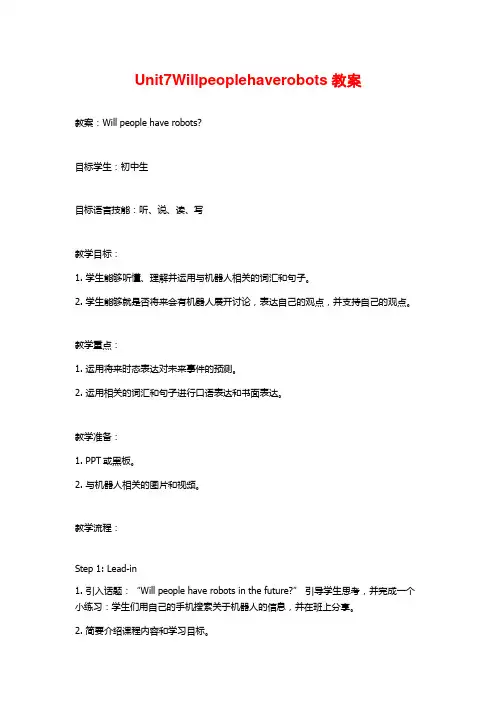
Unit7Willpeoplehaverobots教案教案:Will people have robots?目标学生:初中生目标语言技能:听、说、读、写教学目标:1. 学生能够听懂、理解并运用与机器人相关的词汇和句子。
2. 学生能够就是否将来会有机器人展开讨论,表达自己的观点,并支持自己的观点。
教学重点:1. 运用将来时态表达对未来事件的预测。
2. 运用相关的词汇和句子进行口语表达和书面表达。
教学准备:1. PPT或黑板。
2. 与机器人相关的图片和视频。
教学流程:Step 1: Lead-in1. 引入话题:“Will people have robots in the future?”引导学生思考,并完成一个小练习:学生们用自己的手机搜索关于机器人的信息,并在班上分享。
2. 简要介绍课程内容和学习目标。
Step 2: Presentation1. 通过PPT或黑板上展示与机器人相关的图片和视频,引导学生了解和讨论机器人的现状和未来发展。
2. 教师带领学生学习新的单词和短语,并进行相关练习和操练。
Step 3: Practice1. 学生们分成小组进行讨论,回答问题:“Will people have robots in every household in the future? Why or why not?”2. 学生们可以使用新学到的词汇和句子来支持自己的观点,并通过展示小组演讲的方式分享自己的意见。
Step 4: Listening1. 教师播放一段有关机器人的听力材料,并提问题。
学生们听后,尝试回答问题。
2. 教师再次播放听力材料,并逐句解释和讲解关键词和句子。
Step 5: Reading1. 学生们阅读一篇关于机器人的文章,并回答相关问题。
教师可以提供一些辅助材料,如词汇表或课文大纲,帮助学生更好地理解和回答问题。
2. 学生们可以在小组或全班上展示他们的答案,并进行讨论。
Step 6: Writing1. 学生们根据自己对机器人的想法和预测,写一篇短文。
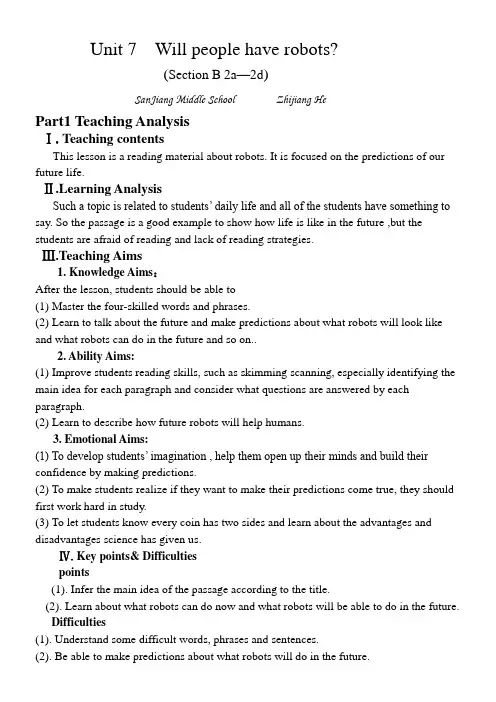
Unit 7 Will people have robots?(Section B 2a—2d)SanJiang Middle School Zhijiang HePart1 Teaching AnalysisⅠ.Teaching contentsThis lesson is a reading material about robots. It is focused on the predictions of our future life.Ⅱ.Learning AnalysisSuch a topic is related to students’ daily life and all of the students have something to say. So the passage is a good example to show how life is like in the future ,but the students are afraid of reading and lack of reading strategies.Ⅲ.Teaching Aims1. Knowledge Aims:After the lesson, students should be able to(1) Master the four-skilled words and phrases.(2) Learn to talk about the future and make predictions about what robots will look like and what robots can do in the future and so on..2. Ability Aims:(1) Improve students reading skills, such as skimming scanning, especially identifying the main idea for each paragraph and consider what questions are answered by each paragraph.(2) Learn to describe how future robots will help humans.3. Emotional Aims:(1) To develop students’ imagination , help them open up their minds and build their confidence by making predictions.(2) To make students realize if they want to make their predictions come true, they should first work hard in study.(3) To let students know every coin has two sides and learn about the advantages and disadvantages science has given us.Ⅳ.Key points& Difficultiespoints(1). Infer the main idea of the passage according to the title.(2). Learn about what robots can do now and what robots will be able to do in the future.Difficulties(1). Understand some difficult words, phrases and sentences.(2). Be able to make predictions about what robots will do in the future.(3). Give opinions about whether it is good for humans to live with a lot of robots in the future.Part2 Teaching MethodsⅠ.Teaching strategiestask-based teaching approachThe whole teaching process will be carried out by learning and reading tasks. During the process, the students will become the real masters of their learning and reading, while the teacher acts as a director. In this way the learners will experience the knowledge and eventually acquire it.2.Reading tutoring methodswith groupsDiscuss what robots look like now and what robots will look like in thefuture .Discuss what robots can do now and what robots will do in the future.and answers.Ⅱ.Learning strategieswordsPart3. Teaching ProceduresStep1.Pre- reading◆Lead- in by showing a video about robots and Presentation some pictures about thistext .◆Disscussion and answerdo you think today`s robots can do?you think people will have their own robots in the future?do you want robots to do? Why?Step2. While-reading1. PredictingLook at the title of the passage and the picture on the book page 53. Predict what the passage is talking about.2.Fast ReadingSkimmingRead the passage quickly and finish 2b. Then get the main idea of each paragraph. Tips: Reading for meaning, not for details3. Careful ReadingRead the passage by paragraph with different tasks.(1) Robots beforeRead paragraph 1, and answer :A. In what kind of movies ,we sometimes see robots?B. What are they like?(2) Robots todayRead Para. 2. complete this sentence.Robots can help to build_____________ in factories and do ______jobs over and over again. They will never get ________.Read Para. 3 It will be ________to make them think like humans.although they can _____like humans.Robots will even be able to ______like humans.(3) Robots in the futureRead Para 4. complete the diagram.Some will look like___________Others will look like___________2d as quickly as possibleStep 4. Homework:A:Complete your dream card and send it to future you.B:Write a short passage about “My Dream Robots”.Blackboard Design:Part 4 Teaching Reflection:During my teaching, I’ll try my best to train every student to own : Language abilityLearning abilityCultural abilityThinking qualityTo students:Nothing is impossible if you put your heart in it!。
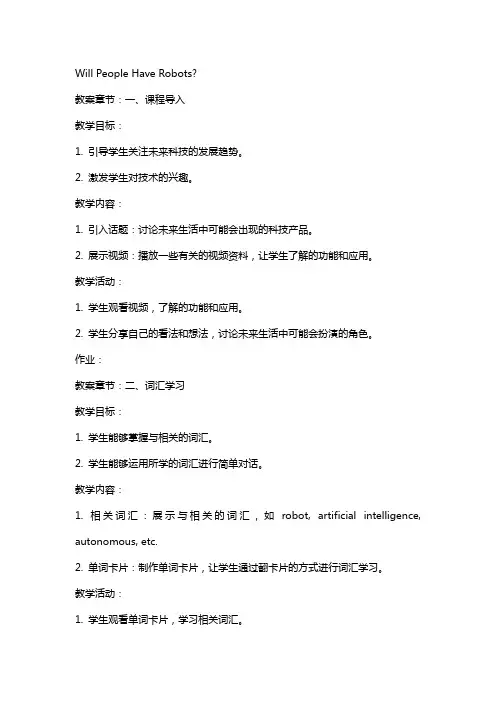
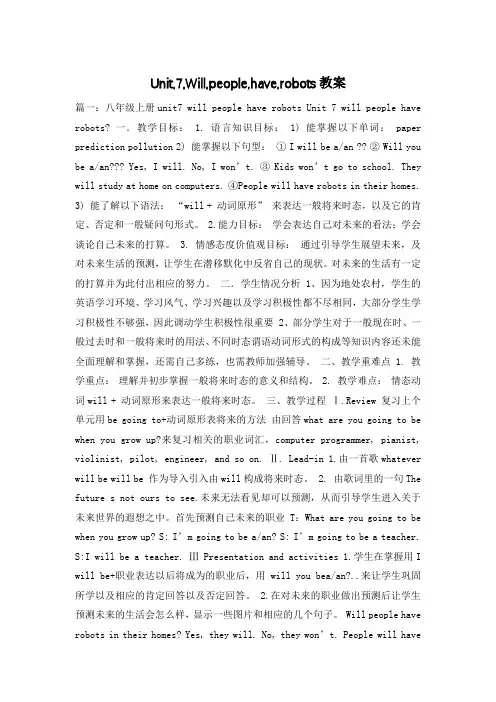
Unit,7,Will,people,have,robots教案篇一:八年级上册unit7 will people have robots Unit 7 will people have robots? 一.教学目标: 1. 语言知识目标: 1) 能掌握以下单词: paper prediction pollution 2) 能掌握以下句型:① I will be a/an ?? ② Will you be a/an??? Yes, I will. No, I won’t. ③ Kids won’t go to school. They will stud y at home on computers. ④People will have robots in their homes.3) 能了解以下语法:“will + 动词原形” 来表达一般将来时态,以及它的肯定、否定和一般疑问句形式。
2.能力目标:学会表达自己对未来的看法;学会谈论自己未来的打算。
3. 情感态度价值观目标:通过引导学生展望未来,及对未来生活的预测,让学生在潜移默化中反省自己的现状。
对未来的生活有一定的打算并为此付出相应的努力。
二.学生情况分析 1、因为地处农村,学生的英语学习环境、学习风气、学习兴趣以及学习积极性都不尽相同,大部分学生学习积极性不够强,因此调动学生积极性很重要 2、部分学生对于一般现在时、一般过去时和一般将来时的用法、不同时态谓语动词形式的构成等知识内容还未能全面理解和掌握,还需自己多练,也需教师加强辅导。
二、教学重难点 1. 教学重点:理解并初步掌握一般将来时态的意义和结构。
2. 教学难点:情态动词will + 动词原形来表达一般将来时态。
三、教学过程Ⅰ.Review 复习上个单元用be going to+动词原形表将来的方法由回答what are you going to be when you grow up?来复习相关的职业词汇,computer programmer, pianist, violinist, pilot, engineer, and so on. Ⅱ. Lead-in 1.由一首歌whatever will be will be 作为导入引入由will构成将来时态。
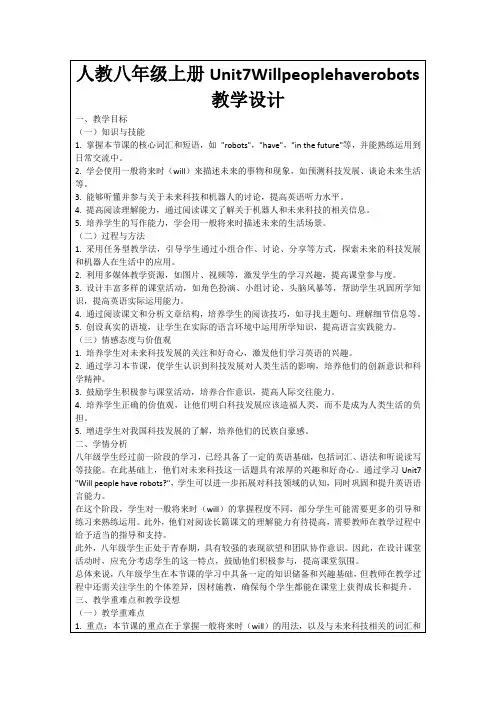

Unit 7 Will people have robots 单元整体设计一、教学目标语言能力:掌握与未来、职业、交通、居住场所及机器人发展等相关话题的词汇,并能在实际情境中运用。
理解并能够正确使用一般将来时态描述未来的情境和预测。
文化意识:了解未来生活可能带来的文化变化,培养跨文化交流的意识。
理解并尊重不同文化背景下的未来预测和生活方式。
思维品质:通过分析和对比过去、现在与未来的生活,培养学生的批判性思维能力。
鼓励学生对未来发展进行预测,培养其创新思维和想象力。
学习能力:培养自主学习的能力,通过提供相关资源,让学生能够独立探索和学习关于未来的主题。
训练学生通过合作学习进行讨论和分享,提高其协作学习的能力。
二、教学内容及步骤学习理解导入:目的:激发学生的学习兴趣和对未来主题的关注。
内容:播放一段关于未来生活的短片,展示未来可能出现的场景和科技。
引导学生讨论和分享他们对未来的想法和预测。
Section A听说部分:(1)词汇学习:目的:帮助学生掌握与未来主题相关的基本词汇。
内容:讲解“机器人”、“自动化”、“未来主义”等词汇的定义、例句和用法。
通过小组活动,让学生使用这些词汇进行造句或简短对话。
(2)听力活动:目的:培养学生的听力理解能力,并让他们熟悉关于未来生活的不同观点和情境。
内容:播放一段关于未来生活情境的听力材料。
设计选择题、填空题等,检查学生是否理解听力内容。
引导学生分享他们从听力中获取的信息和感受。
(3)口语练习:目的:鼓励学生表达对未来生活的看法和预测,提高其口语表达能力。
内容:设计一个关于未来生活的主题讨论,如“我心目中的未来城市”、“未来职业的发展趋势”等。
组织学生进行小组讨论,鼓励他们积极发表自己的观点,并从课本和教师提供的资源中寻找支撑证据。
在讨论后,邀请几个小组代表上台分享他们的想法。
应用实践Section B知识技能部分:(1)语法聚焦:目的:让学生掌握一般将来时的基本结构和用法,能够在口语和书面语中正确运用。
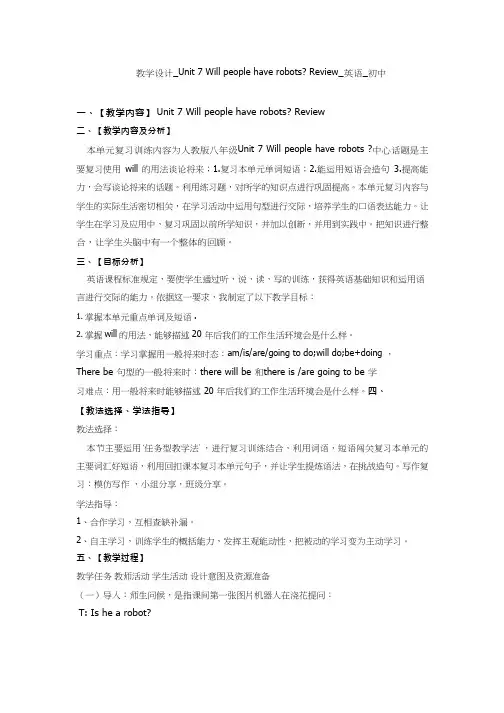
教学设计_Unit 7 Will people have robots? Review_英语_初中一、【教学内容】Unit 7 Will people have robots? Review二、【教学内容及分析】本单元复习训练内容为人教版八年级Unit 7 Will people have robots ?中心话题是主要复习使用will 的用法谈论将来;1.复习本单元单词短语;2.能运用短语会造句 3.提高能力,会写谈论将来的话题。
利用练习题,对所学的知识点进行巩固提高。
本单元复习内容与学生的实际生活密切相关,在学习活动中运用句型进行交际,培养学生的口语表达能力。
让学生在学习及应用中,复习巩固以前所学知识,并加以创新,并用到实践中。
把知识进行整合,让学生头脑中有一个整体的回顾。
三、【目标分析】英语课程标准规定,要使学生通过听,说,读,写的训练,获得英语基础知识和运用语言进行交际的能力。
依据这一要求,我制定了以下教学目标:1.掌握本单元重点单词及短语.2.掌握will 的用法,能够描述20 年后我们的工作生活环境会是什么样。
学习重点:学习掌握用一般将来时态:am/is/are/going to do;will do;be+doing ,There be 句型的一般将来时:there will be 和there is /are going to be 学习难点:用一般将来时能够描述20 年后我们的工作生活环境会是什么样。
四、【教法选择、学法指导】教法选择:本节主要运用“任务型教学法”,进行复习训练结合,利用词语,短语闯关复习本单元的主要词汇好短语,利用回扣课本复习本单元句子,并让学生提炼语法,在挑战造句。
写作复习:模仿写作,小组分享,班级分享。
学法指导:1、合作学习,互相查缺补漏。
2、自主学习,训练学生的概括能力,发挥主观能动性,把被动的学习变为主动学习。
五、【教学过程】教学任务教师活动学生活动设计意图及资源准备(一)导入:师生问候,是指课间第一张图片机器人在浇花提问:T: Is he a robot?Ss:Yes.T:What’s he doing ?Ss:He’s watering the flowers.T:Do you like him ?Ss:Yes.T: Do you want to have one?Ss:Yes.T:Today ,we are going over Unit 7 Will people have robots?引入课题(二)出示目标,让学生齐读,让学生明白我们这节可要干什么。
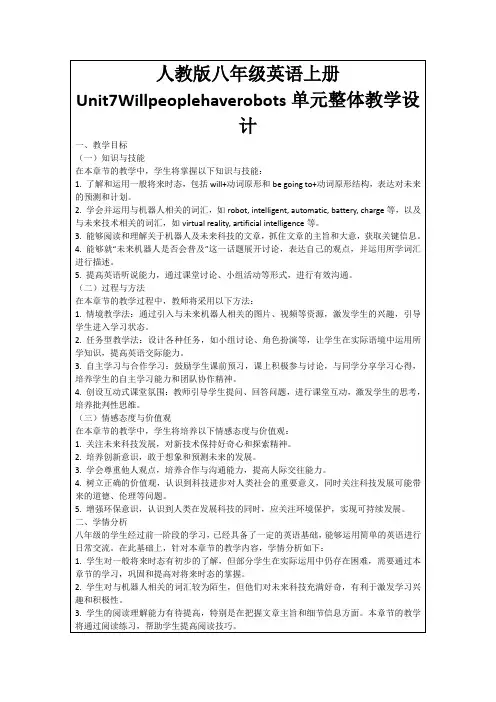
Unit 7 Will people have robots?Period 1 Section A 1a-2cTeaching aims:1. Students learn to talk about future intentions.2. .The students will be able to learn the words and phrases:will , won’t , in the future, predict, prediction, paper, live to be , world peace, there will be , there won’t be …3. The students will be able to use the expressions:(1). What will the future be like ?(2). People will live to be 200 years old.(3). People won’t go to work in 100 years.(4). Will people use money in 100 years?--- Yes, they will. ---No, they won’t.(5). There will be more free time in the future.(6) There won’t be much pollution in the future.(7)There will be more/ less/ fewer …Ability aims:1.The students can use the questions to get information to improve their listening andspeaking abilities.2.To train the students’ cooperation with their partners.Key and important difficult points:A. VocabularyB. Target language(1). What will the future be like?(2). People will live to be 200 years old.(3). People won’t go to work in 100 years.(4). Will people use money in 100 years?--- Yes, they will. ---No, they won’t.(5). There will be more free time in the future.(6) There won’t be much pollution in the future.(7)There will be more/ much/less/ fewer …C.Grammar: The simple future tense.Emotional aims:To help the students to make their future plan and play a part in saving the earth!Teaching procedures:Before class: Students learn by themselves.Step 1 Warming up.1. Listen to a song.2. Show the title.Step 2 New language presentation.1. T: What will I be in 20 years ?I will be a grandmother. I won’t be a teacher in 20 years.won’t= will not (将不会)Write; I will be..I won’t be…. won’t= will not (将不会)2. Pair work.A: What will you be in 20 years ? B: I will be a/ an __________.A: How will you do that? B : I will ____________.Write : I will practice playing basketball.3. T; What will our life be like in 100 years?(1). Demonstrate; Learn and read.(2). Students learn in their group.(3). Read.Step 3 Work on 1a.1. Read the sentences.2. How will the world be different 100 years from now? Read the predictions in 1a. Check Afor agree or D for disagree.3. Show their answers: I agree /disagree that ____________________.Step 4 Work on 1b.1. T: Now listen to the recording and circle the predictions you hear in 1a.2. Play the recording for the Ss to listen and circle the predictions.3. Play the recording again.4. Check the answers with the Ss.5. Read .Step 5.Pair work.1. Let Ss read the first conversation in 1c after the teacher.2. Then let Ss ask and answer questions about the predictions in 1a. Then make their ownconversation.3. Let some pairs ask and answer about their conversations.Step 6Step 2 New language presentation.T: Make more predictions.Structures :Will there be more schools? Yes, there will. / Yes, there won’t.There will be more people.Step 7 Work on 2a:1. Read the sentences in 2a. Tell Ss they will listen to some sentences. They should listen andcircle the words in the bracket.2. Play the recording for the Ss to listen and circle the words.3. Play the recording again to check the answers.Work on 2b:1. Let Ss read the sentences below. Explain some main sentences for the Ss. Make sure theyknow what to do.2. Play the recording for the Ss to check the predictions they hear.3. Play the recording again to check the answers.Step 8 Game.Predict the world in the future. You can make predictions about 2 or 3 things such as the robots, the schools and so on.We will…We won’t…There will be more/ less/ fewer …Step 9 Summarize and do some exercises.板书:Unit 7 Will people have robots?Period 1 Section A 1a-2cI will be..I won’t be…. won’t= will not (将不会)A: Will people use money in 100 years?B: No, they won’t. Everything will be free.Will people live to be 200 years old?A: Yes, they will. People will live to be 200 years old.Will there be more schools? Yes, there will. / Yes, there won’t. There will be more people.Period 2 Section A 2d-3cTeaching aims:1.The students will be able to learn the words and phrases:future,pollute, environment,planet,earth,play a part,world peace, sea, sky2. The students will be able to use the expressions:(1) A: Will you live to be 200 years old? B: Yes, I will. / No, I won’t.(2) Kids will study at home on computers.(3) They won’t go to school.3. The students will be able to use “more, less, fewer”.(1) There will be more cars.(2) There will be more pollution.(3) There will be less free time.(4) There will be fewer trees.Ability aims:2.The students can use the questions to get information to improve their listening andspeaking abilities.2.To train the students’ cooperation with their partners.Key and important difficult points:A. VocabularyB. Target languageD.Grammar: The simple future tense.Emotional aims:To help the students to make their future plan and play a part in saving the earth!Teaching procedures:Before class: Students learn by themselves.Step1: Warming up ----Listen to a song.Step2: Lead—in1. Show the pictures and talk about the earth.What will the earth be like in ten years?New words: pollute, environment, planet., earth, in great danger, play a part.2. What will you do for the earth?I will…Step 3: Work on Section A 2d.1. Read the conversation quickly and answer two Qs.2. Listen and repeat. Then read aloud for 5 minutes to recite.3. Role--- play the conversation.4. Make their own conversations.Step 4 Grammar focus.1. Show the sentences and think, What are the rules?仔细观察例句,体会并写出画线部分的时态结构,并翻译时间状语。